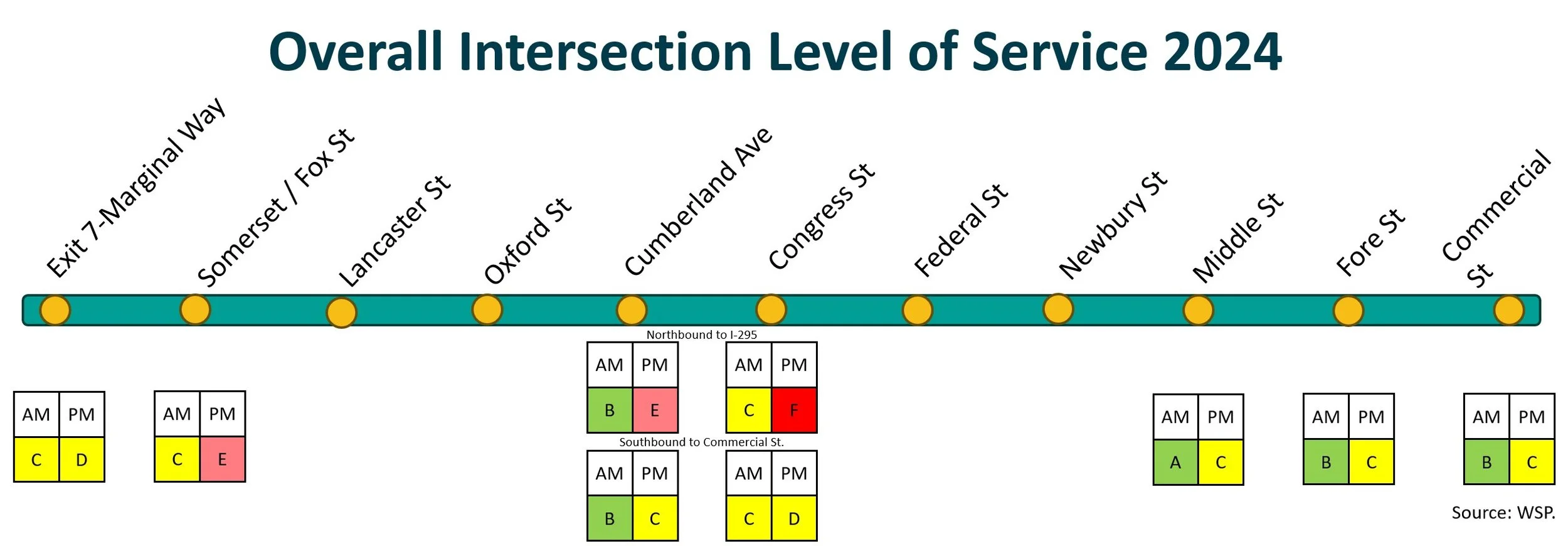
Refine
The Refine phase is the heart of the project, where most of the engineering and design work happens. This phase began with understanding Franklin Street today and the recommendations of the 2015 Franklin Street Feasibility Study - these served as as starting points for refining and updating the design of Franklin Street to meet the needs of today and the future.
Franklin Street Today
Franklin Street and its context changes as it traverses from Exit 7 and Marginal Way at the north end to Commercial Street at the south. There are four distinct character zones.
Vehicular Infrastructure
Franklin Street generally maintains a consistent two lanes in each direction at its seven signalized intersections with dedicated left turn lanes at three intersections (Marginal Way, Somerset/Fox and Commercial Street) and otherwise, left turns from the inside travel lane. At both Cumberland Avenue and Congress Street, there are two separated intersections that often create bottlenecks at the inside lanes due to left-turning vehicles and short stacking distance between the signals.
Bicycle + Pedestrian Infrastructure
Franklin Street has a sidewalk on at least one side for its entire length, but the discontinuity of sidewalks and the distance between and across street crossings makes walking its full length difficult. From Marginal Way to Middle Street, the sidewalk is generally asphalt and 5 feet in width next to the street. From Middle Street to Commercial Street, the sidewalk widens and changes in character to more of a typical downtown street. The streets that were discontinued in the 90’s when the current Franklin Street was constructed create huge gaps in east-west connections, particularly for bicyclists and pedestrians. It is approximately 1,200 feet between crossings at Somerset/Fox Street and Cumberland Avenue and approximately 800’ from Congress Street to Middle Street. The gaps in sidewalks compound the large distances between crossings.
There are no bikeways on Franklin Street today. Some sections of the street have a 3 foot - 5 foot shoulder. Shared use pathways - the Bayside Trail and Eastern Promenade Trail - connect at the north and south ends of Franklin Street.
Traffic volumes change dramatically from north to south on Franklin Street. Afternoon peak hour traffic (which occurs from 4:30-5:30 PM) drops by about 30% between Marginal Way and Congress Street, and by more than 70% from Marginal Way to Commercial Street.
Comparing 2013 traffic levels to 2024 traffic levels show different trends on Franklin Street. At the north end, traffic volumes in both the morning and afternoon peak periods were relatively flat with slight declines or little increase. There was modest increase at Cumberland and Congress, with generally higher increases at Middle and Fore Streets. Traffic changes were essentially flat at the south end at Commercial Street.
Level of Service (LOS) - typically shown by a letter grade - refers to the average delay encountered by vehicles as they move through an intersection with a traffic signal. An intersection with LOS A has almost no delay while a LOS F shows high levels of delay. Existing traffic during the afternoon peak hour shows higher levels of delay than the morning peak on Franklin Street.
The 2023 GPCOG Vision Zero Action Plan identified regional critical safety corridors and intersections. Franklin Street was identified as a critical safety corridor and five of its intersections were identified as critical safety intersections. These locations were determined by identifying where the worst crashes have happened, where crashes are more likely to occur, where transportation disadvantaged communities live, and where community members have safety concerns
Refining the Street Design
The June community design workshop gave us a chance to connect with over XXX members of the community to talk directly about changes to the design of Franklin Street.










